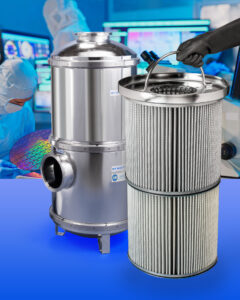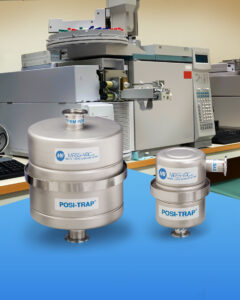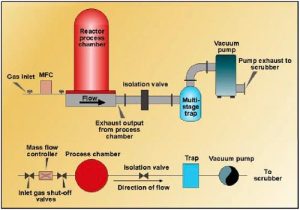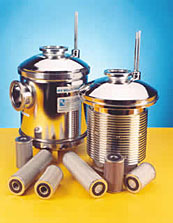
Vacuum Pump Inlet Trap For Heavy Contaminant Vacuum Processes
A high-capacity vacuum pump inlet trap designed to remove high quantities of contaminants from LPCVD, PECVD, MOCVD, HVPE, ALD and similar processes has been introduced
Another common application for a multiple-stage vacuum pump trap is a CVD (chemical vapor deposition) process to deposit silicon dioxide onto silicon wafers. Silicon dioxide dust wears at a vacuum system, reducing pumping efficiency. Liquid silicon dioxide sources, such as tetraethylorthosilicate (TEOS), can recondense in the vacuum lines, causing valves to stick and product runs to be lost. With most silicon dioxide sources, multi-stage trapping reduces these problems, saving the user time and money.
SEMATECH, a semiconductor research consortium, installed a four-stage trap in a single-wafer TEOS reactor. The trap reduced the preventive maintenance frequency from once per shift to once every three months. SEMATECH estimates that the trap added 250 hours of operation per year to the system.
At another company, a batch reactor running TEOS averaged a pump failure every 6 months. To minimize these failures, the user performed preventive maintenance every 47 runs. To reduce the occurrence of pump failures, the user installed a three-stage trap, consisting of a knock-down stage, a stainless steel gauze filter and a 20-µm polypropylene filter. After installation of the trap, the user reported no pump failures for over one year and had increased the time between preventive maintenance sessions to every 88 runs.
In these examples, the cost savings include reduced line yield losses due to pump failure, reduced costs for pump rebuilding and a slight capacity increase.
A silane-based doped silica deposition process in a batch reactor provides similar results. One user had frequent pump failures and exhaust line clogging, despite the presence of a single stage trap in the vacuum line. This trap used only a knock-down stage and required cleaning every 6,000 nm of deposition, or every two days. Once installed, the multi-stage trap requires cleaning every 35,000 nm, which occurs only every ten days. Inspection during cleaning shows heavy silicon dioxide powder accumulates in the knock-down stage, followed by a light powder coating of the filter elements. No accumulation appears in the vacuum line outside the trap, giving a good indication that clogged lines have been eliminated as a source of vacuum line failure. This multi-stage trap saved the user $14,600 – more than four times the cost of the trap (see Table 1).
Silicon nitride and silicon dioxide films may also be deposited using plasma-enhanced chemical vapor deposition (PECVD) processes. Plasma processes produce the same type of effluent as LPCVD systems, and plasma vacuum systems fail for the same reasons. In one process running silicon nitride, pump failures occurred every two to three months. In this case, a three-stage trap cleaned up the vacuum system. This trap consists of the knock-down stage, then a stainless steel gauze filtration stage followed by a 5-µm polypropylene filter stage. This trap allowed the user to reduce maintenance frequency from every 25,000 nm to every 50,000 nm of deposition, allowing up to 30 days between preventive maintenance.
Another user did not perform routine preventive maintenance on the vacuum system of a PECVD system, resulting in pump failures every two months. To eliminate these failures, the user installed a four-stage trap consisting of knock-down, water cooling, a stainless steel gauze filter and a 5-µm polypropylene filter. The trap requires cleaning after 60 days of service. The result is a scheduled down period of about four hours every two months, in place of a catastrophic failure at about the same frequency.
In the case of a different PECVD system, a multi-stage trap installed downstream of the pump solved clogging problems in the lower stage of the dry pump. Initial installation consisted of a knock-down stage and a stainless steel gauze filtration stage, followed by a 5-µm polypropylene filter stage. This setup required cleaning every 6-8 days. To reduce the cleaning frequency, the user replaced the 5-µm polypropylene filters with 20-µm filters. While there is too little data to calculate a payback for this user, they no longer find particles logging the lower stage of the pump, and they report a significant reduction in required maintenance.

A high-capacity vacuum pump inlet trap designed to remove high quantities of contaminants from LPCVD, PECVD, MOCVD, HVPE, ALD and similar processes has been introduced

A line of robust vacuum pump exhaust traps for use with dry scroll pumps to remove carbon soot which can damage recirculation systems has been introduced

Cleaning up an LPCVD Silicon Nitride Deposition System A typical application for a multiple-stage vacuum pump trap is a reactor that deposits silicon nitride (Si3N4)

Throughput Increases in Silicon Dioxide Deposition Systems Another common application for a multiple-stage vacuum pump trap is a CVD (chemical vapor deposition) process to deposit

Multi-Stage Traps Clean Up Vacuum Systems Cleaning up an LPCVD Silicon Nitride Deposition System A typical application for a multiple-stage vacuum pump trap is a

Multi-Stage Traps Clean Up Vacuum By Herbert W. Gatti and Lise C.H. Laurin The costs involved in maintaining vacuum processes in a manufacturing facility can
247 Rangeway Road
PO Box 359
North Billerica, MA 01862-0359
P: 978 667 2393
F: 978 671 0014
Email: sales@massvac.com
© 2024 MassVac Inc.
Webdesign by Turek Design